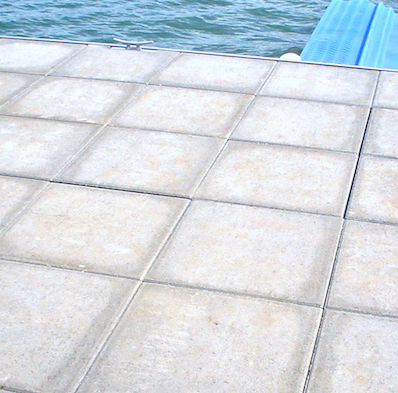![]() ATTENTION FUTURE DOCK BUYERS:
ATTENTION FUTURE DOCK BUYERS:
It has been brought to my attention that a dock vendor is promoting concrete decking stating, “…It will make a dock structurally stronger and assist in heavy boat traffic.”
There are several problems with this statement that I would like to elaborate on.
But first let me acknowledge this – yes, the additional weight of concrete will help with less dock motion in heavy boat traffic.
Having said that, concrete decking does nothing for the structural integrity of the dock. This deserves repeating: Concrete decking does nothing for the structural integrity of the dock. What it does do is add more stress on a dock due to its excessive weight.
Think about it, if you place a huge load of concrete in the back of your truck, does this make your truck more structurally sound? Does it make your truck stronger simply because it’s in the bed? The answer is of course no. All you’ve done is add weight to the truck.
Concrete decking is free floating and is not fastened to floor joists. It is simply placed on top of the joists. Wood is utilized around the perimeter of the dock and bays to help secure the concrete. Therefore, the decking serves no purpose in stabilization of the flooring and serves no purpose structurally. This is very important.
 Many consumers are confused about where the structural strength of a boat dock lies. Many think it’s similar to a house and that the strength is in its foundation. This is simply not the case. In a properly built boat dock, the structural strength is in its framework and roof structure.
Many consumers are confused about where the structural strength of a boat dock lies. Many think it’s similar to a house and that the strength is in its foundation. This is simply not the case. In a properly built boat dock, the structural strength is in its framework and roof structure.
The reason for this is because of the long, open span of the bays/wet slips. It is the structural integrity of the roof/truss system that provides the strength. The roof system is as equally as important as the rest of the frame.
Example: The standard size of a modern boat dock bay is 28 feet in length and the standard overall length of a boat dock is 32 feet. Therefore, if you are depending on the docks flooring for its strength, you are relying on the 4 feet on the shoreline side. With the amount of traffic on Smith Lake, this is simply not sufficient. It’s not even sufficient for the normal spring storms.
Concrete decking even hurts the structural integrity on these lighter frame docks the competitors sell. We all know Newton’s F=ma (Force equals mass X acceleration). When you add the weight of concrete, your frame and joints still have to support it.
Example: Say one of our “beloved” wakeboard boats comes by with all of its water tanks full. Water is definitely going to be displaced. Wake rolls under the dock and the frame of the dock must support the additional weight of the concrete or “mass”. Keep in mind these are floating structures so they will move as the water moves. Thus, you have acceleration. As you can see, the frame is the most important aspect of your floating dock.
Three years ago, before we started carrying concrete decking, I looked at several docks made by several different companies. On all of the docks I noticed the following – as boats went by and the wake would hit the docks, the outer fingers of the wet slips/bays would sway in and out. This movement stresses the joints of the docks, not to mention the boat lifts inside the bays. This is one of the prime examples of concrete actually adding stress to the frame.
Concrete decking can also be somewhat difficult to clean (between the cracks) and does not have a manufacturer warranty. From a maintenance standpoint, aluminum decking is by far the best option. Aluminum decking is very easy to clean and has a true lifetime warranty.
Free State Boat Docks does offer concrete decking as one of our flooring options. But we offer it ONLY because we have perfected the structural frame to accommodate it. We tell all of our customers it is strictly their choice what style decking they choose.
Remember this: decking has absolutely zero structural benefits.
Justin Hogan
Free State Boat Docks, Inc.
Excellence Since 1996